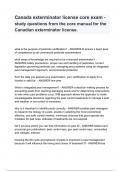Canada
exterminator
license
core
exam
-
study
questions
from
the
core
manual
for
the
Canadian
exterminator
license.
what
is
the
purpose
of
pesticide
certification?
-
ANSWER-to
ensure
a
basic
level
of
competence
by
all
commercial
pesticide
exterminators
what
areas
of
knowledge
are
required
to
be
a
licensed
exterminator?
-
ANSWER-safety
precautions.
proper
use
and
handling
of
pesticides,
current
legislation
governing
pesticide
use,
managing
pest
problems
using
an
integrated
pest
management
approach,
environmental
protection
from
the
date
you
passed
your
examination,
your
certification
to
apply
for
a
license
is
valid
for:
-
ANSWER-one
year
What
is
integrated
pest
management?
-
ANSWER-a
decision
making
process
for
preventing
pests
from
reaching
damaging
levels
and
for
determining
what
actions
to
take
when
pest
problems
occur.
IPM
approach
allows
the
applicator
to
make
knowledgeable
decisions
regarding
the
pest
control
treatments
to
manage
a
pest
and
weather
or
not
control
is
necessary
why
is
it
important
to
identify
pests
correctly
-
ANSWER-enables
pest
managers
to
research
the
biology
of
a
pest.
assists
in
selecting
the
most
economical,
effective,
and
safe
control
method.
minimizes
chances
that
good
species
are
mistaken
for
bad
ones.
indicates
if
treatments
are
not
required.
list
5
sources
where
you
can
find
information
on
pest
ID
-
ANSWER-federal
and
provincial
gov
publications.
pest
control
reps.
gov
pest
control
reps.
universities
and
colleges.
internet.
knowing
the
life
cycle
and
behavior
of
pests
is
important
in
pest
management
because
it
will
influence
the
timing
and
choice
of
treatment
t/f
-
ANSWER-true what
information
can
be
determined
through
regular
monitoring
-
ANSWER-locate
the
centre
of
an
infestation,
find
the
cause
of
a
pest
problem,
select
and
revise
injury
and
action
thresholds,
control
the
pest
only
when
needed,
assess
treatment
results.
a
pest
population
which
is
below
the
action
threshold
should
be
controlled
t/f
-
ANSWER-false
describe
the
term
threshold
-
ANSWER-the
threshold
limit
is
the
specific
number
of
pests
at
which
you
must
take
pest
control
action
if
you
want
to
prevent
the
pests
from
causing
unacceptable
damage
loss
or
harm.
list
5
types
of
pest
management
practices
and
provide
examples
for
each
-
ANSWER-legislative-
destruction
of
noxious
weeds.
cultural-
crop
rotation.
mechanical-
traps.
biological-
introduce
predators.
behavioral-
releasing
of
sterile
males
to
stop
reproduction.
chemical-
synthetic
pesticides.
what
environmental
conditions
may
alter
the
selection
or
use
of
a
pest
management
practice
-
ANSWER-temp,
relative
humidity,
precipitation,
wind
speed
and
direction,
distance
to
sensitive
areas,
topography.
lest
5
factors
to
include
in
an
evaluation
of
an
IPM
program
-
ANSWER-make
post
treatment
observations
on
pests
and
non
targets.
compare
post
treat
results
with
pre
treat
records.
review
of
records
including
costs,
dates,
methods,
etc.
obtain
feedback
from
clients
or
others.
id
any
possible
improvements.
What
is
a
pesticide?
-
ANSWER-anything
intended
to
control,
prevent,
destroy,
repel,
attract,
or
manage
a
pest.
difference
between
selective
and
systemic
pesticides
-
ANSWER-a
selective
pesticide
is
toxic
to
some
pests
and
has
little
or
no
effect
on
others.
a
systemic
pesticide
is
absorbed
by
the
plant
and
moves
around
inside
of
it
to
parts
of
the
plant
that
are
remote
from
the
point
of
application. what
is
a
chemical
group
and
why
do
we
use
them
-
ANSWER-a
chemical
family
is
a
group
of
chemicals
that
have
similar
chemical
structures
and
properties,
similar
poisoning
symptoms,
similar
first
aid,
and
safety
guidelines.
we
do
this
because
it
helps
an
applicator
know
how
pesticides
work
and
how
to
use
them.
the
name
given
by
the
manufacturer
to
a
product
that
is
unique
and
prominently
displayed
is
the
product
name.
t/f
-
ANSWER-true
a
pesticide
formulation
is
a
mix
of
active
ingredients
and
formulants
-
ANSWER-true
wettable
powder
pros,
cons
-
ANSWER-containers
empty
easily,
no
liquid
spills,
easy
to
store
in
cold.
disadvantages:
dusty,
requires
agitation
to
remain
suspended,
may
leave
visible
residue,
may
be
abrasive
emulsifiable
concentrate
pros,
cons
-
ANSWER-high
conc.
ai,
not
abraisive,
less
visible
residue,
buy
less
bulk.
disadvantages,
possibly
flammable,
possibly
phytotoxic
solution
pros
cons
-
ANSWER-high
conc.
ai,
not
abrasive,
less
visibel
residue,
buy
less
bulk,
requires
little
agitation.
disadvantages,
may
be
corrosive
3
factors
that
may
result
when
2
pesticides
are
mixed
together
-
ANSWER-loss
of
effectiveness,
non
target
injury,
settling
of
solids
and
or
clogging
of
equipment.
difference
between
stomach
and
contact
insecticides
-
ANSWER-stomach
insecticides
must
be
eaten
to
go
to
the
stomach
to
be
effective,
contact
insecticides
enter
through
the
exoskeleton
what
type
of
insecticide
requires
the
insect
to
touch
a
treated
area
to
be
effective?
-
ANSWER-non
systemic,
also
called
contact.
what
is
a
micro-encapsulated
suspension?
-
ANSWER-a
suspension
with
the
ai
in
micro
capsules
in
liquid
which
gives
a
slow
release
of
the
ai




